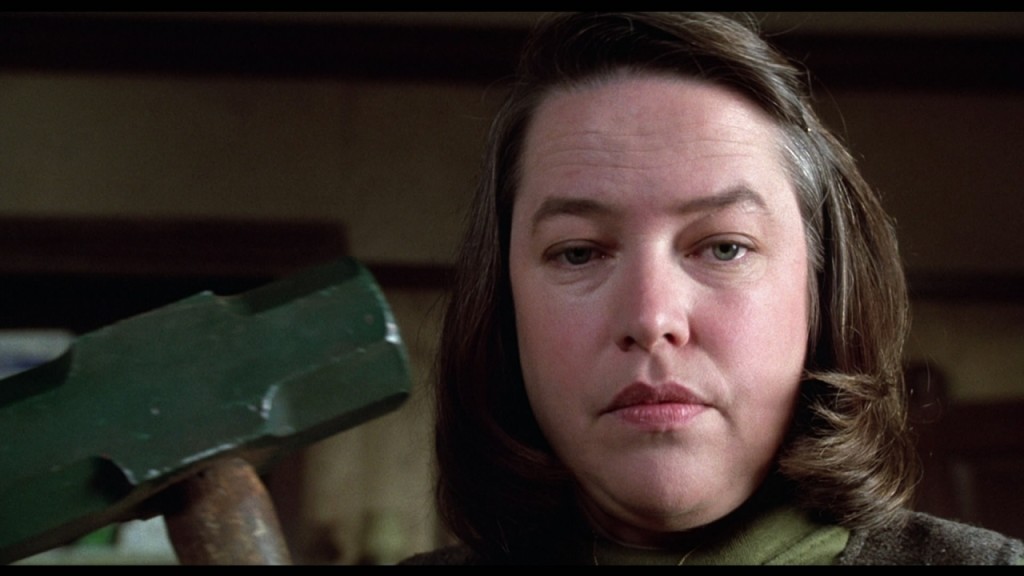
Remember a couple of years ago when every other spec was a contained thriller? Well, believe it or not, the sub-genre got its start a lot earlier than that. In fact, author Stephen King loved writing contained thrillers, with Misery being his most famous. The movie is the result of three artists at the top of their game. Rob Reiner (who directed the film) had just kicked ass with another King adaptation, Stand By Me. King’s books were being adapted every other day in Hollywood, including the recent hit, The Running Man. And Goldman had just come off The Princess Bride. Misery is built on an old writing adage – Place your hero in the worst situation possible, then watch them try to get out of it. It also operates on the notion that you want to torture your main character as much as possible. Some would argue that King went a little too far in that capacity, but it’s hard to argue with the end result. Misery is also a study in how to write a great character, as Annie Wilkes (played by Kathy Bates – who won an Oscar for the role) is one of the most unforgettable villains of all time. It should also be noted that I could TOTALLY see one of these middle-aged Twilight moms doing this to Stephanie Meyer today. So we may get a Misery re-imagining soon!
1) When you write a movie that takes place in a contained area, the most important tools at your disposal are suspense and conflict. – In a contained thriller, you must continuously imply that something bad is going to happen (which is typically done in the first act), and almost every scene after the first act should be steeped in some sort of conflict. Annie being angry at Paul for writing a bad chapter (conflict), Annie telling Paul he needs to burn his manuscript when he doesn’t want to (conflict), Paul telling Annie his new writing setup isn’t good enough (conflict). Conflict and suspense. Suspense and conflict. They are your saviors in contained thrillers.
2) The most interesting battle is often the battle within a character – We were talking about this yesterday with Gatsby and I think it’s important to note here as well, as we see it with Annie. Conflict WITHIN a character often leads to most entertaining type of character. Annie is both loving and kind, but also manipulative and hateful. She wants to be good, thinks of herself as good, but is in fact a monster. Watching her battle this is both fascinating and horrifying. We’ve seen this with Darth Vader, Michael Corleone, Bruce Banner. It’s why Dr. Jeckyll and Mr. Hyde still survive as one of the most memorable characters in literary history. The more intense the conflict is within one’s self, the more interesting the character tends to be.
3) Try to write career-making roles – When you read Misery, you just KNOW that whoever plays Annie – it’s going to change her life forever (as it did for Kathy Bates!). That’s how complicated and interesting and unexpected and crazy and scary and challenging the character is. You would’ve seen the same thing for Hans while reading Inglorious Basterds, or Ferris while reading Ferris Bueller’s Day Off. Look at your script. Are there any career-making roles in there for actors? If not, maybe reevaluate your script and see if you can do something more compelling with at least one of those key characters.
4) The more you set up a scene, the more powerful that scene will be – For a scene to really pack a punch, it needs high stakes. And high stakes only come through repeated set-ups. One of the best scenes in Misery is when Paul plans to poison Annie with the powder from all the pain pills he’s saved. We watch him meticulously hide and hoard these pills over time. This way, when he invites Annie to dinner and secretly poisons her wine – there’s SO MUCH riding on the moment because we know how much effort Paul’s put into this. It’s also why, of course, when she accidentally spills the wine, we’re devastated. There was SO much on the line since it took him SO long to save those pills. This scene does not work if there’s no setup, if we don’t’ see Paul hiding those pills over time. Continuous set-up results in higher stakes results in bigger more intense scenes.
5) When you’re stuck in a room with a lot of dialogue, you have to look for ways to change things up so the dialogue remains interesting. – Too many writers don’t put enough energy into thinking how they can change the feel or tone or undercurrent of a scene. Note the scene near the 30 minute mark where Paul has to pee in a bedpan while talking with Annie. It’s embarrassing and weird, but most importantly, it gives the dialogue a different twist. There’s a different undercurrent to their conversation because of the awkwardness. This is SO important when you have a bunch of talky scenes in a single location. Keep changing up the feel in the room!
6) Go the opposite to be scary – The scariest things usually aren’t obvious and in your face. They’re reserved or the opposite of what you’d expect. Instead of someone screaming at you, it might be that they talk very quietly and rationally. Instead of someone beating you up, it might be that they’re overly, almost oddly, kind to you. We see this with Annie in her language. She doesn’t believe in swearing, so that when she’s upset, her rants are almost comical. But it’s that lack of the obvious that actually makes these rants so scary. “I thought you were good, Paul, but you’re not good, you’re just another lying old dirty birdie and I don’t think I better be around you for awhile.” Had Annie yelled instead, “Fuck you you asshole. I fucking hate you!” It just wouldn’t have had the same eerie effect.
7) No choice in your script should be random – Every choice you make in your story, there should be a reason behind it, right down to the smallest detail. Take what Annie does whenever she’s outside of Paul’s room, for instance. She watches her favorite show: “Love Connection.” That’s no coincidence, as this theme of Annie being in love with Paul is established throughout Misery. Had she been a huge fan of, say, the sitcom “Taxi,” it wouldn’t have fit into the story as nicely.
8) If you jump into your story right away, your “first act break” has to work like a mid-point. – Typically, in a regular story, the first act break is when the hero begins his journey (like Luke, in Star Wars). But in Misery, Paul is captured by page 5, and has been kept in this room for 20-25 pages already. If you continue on with this setup without any significant changes, the audience will get bored. So you almost use your first act break as a mid-point, as a way to twist the story, up the stakes, and set us off in a new direction. That occurs here when Annie finds out Paul killed her favorite character, Misery. She freaks out and threatens Paul, letting him know that she’s controlling this show and he’s her fucking slave from this point forward (note: you will still use a REAL mid-point break later as well).
9) Most heroes should come into a story trying to make some sort of change in their lives – Change is what makes characters and stories interesting. If all anybody’s trying to do is live the exact same life and do the exact same things they’ve always done, how interesting is that going to be? Therefore, Paul isn’t working on Misery 11 when we start the story. He’s just written his first non-Misery novel in a decade. It’s a huge risk for him, a big CHANGE in his life. And it’s what makes his character more interesting than if he was just trying to do the same old boring thing.
10) Each scene must push the story forward, not repeat the story. – A big mistake I see in these kinds of scripts is that each successive scene isn’t really different from the previous one. For example, a bad writer would have Annie be mean in one scene, and the next time she comes around, she’s mean again. Maybe mean about something else, but still mean. In other words, you’re not evolving the story. You’re repeating yourself. Instead, every time Annie comes in the room, she should have a new agenda, a new goal. First it’s to meet her favorite writer. Then it’s to ask about his new book. Then it’s to talk about her dislike of the new book. Then it’s to introduce her best friend (a pig). Then it’s to yell at him for killing off Misery. Then it’s to have him burn his manuscript. It is SO EASY to repeat scenes in contained thrillers because of the limited location. Don’t fall into this trap. Do something new with each scene.
 These are 10 tips from the movie “Misery.” To get 500 more tips from movies as varied as “Aliens,” “Pulp Fiction,” and “The Hangover,” check out my book, Scriptshadow Secrets, on Amazon!
These are 10 tips from the movie “Misery.” To get 500 more tips from movies as varied as “Aliens,” “Pulp Fiction,” and “The Hangover,” check out my book, Scriptshadow Secrets, on Amazon!

